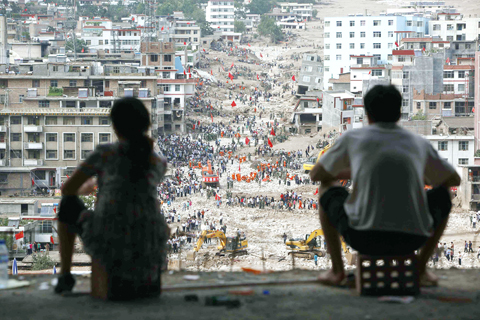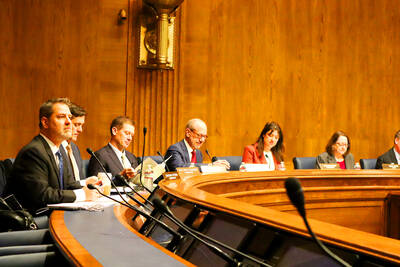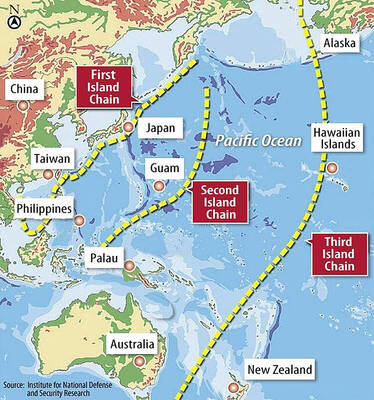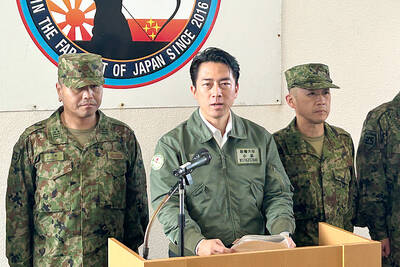Wails of grief echoed through a northwest Chinese town half-smothered by a landslide two days ago, as relatives washed mud-caked bodies pulled from ruins and desperately hunted for survivors.
The death toll from the disaster in Gansu Province crept up to 137 in an official estimate released by state media later yesterday — a count likely to mount — making it the worst single such incident in a year of grim floods.
Nearly 1,500 people have already died in landslides and flooding caused by months of torrential rains across the country, the Ministry of Civil Affairs said.

PHOTO: REUTERS
Rescuers and locals with just shovels, hoes and rope spread over more than 2km of devastated land to burrow into homes engulfed by a torrent of mud and floodwater that swept down from the slopes around Zhouqu in Gansu late on Saturday night.
“There are around 20 of my family members under there,” said Zou Jianglian, who had rushed back from a job in the nearby town of Wuwei to search for her mother, father, younger brother and other relatives lost since the disaster.
Relatives of the 1,348 people that officials say are still missing in Zhouqu trekked into the disaster zone, some helping with excavation efforts while others watched in desperate hope.
Hopes rose when a 74-year-old woman was found alive yesterday morning, Xinhua news agency reported. She had been trapped in a fourth floor apartment rather than the low-rise buildings almost obliterated by rocks and sludge.
Chinese Premier Wen Jiabao (溫家寶) visited the town, still two- thirds underwater, for a second day and hollered at rescuers and survivors not to give up, state television news showed.
In the worst hit-village not a single structure was intact, although rescuers said they had not given up hope.
“There are probably eight people buried under this site,” said a soldier, Luo Siyuan, who was helping dig for survivors in Zhouqu town. “They might not be able to survive after such a long time, but we will not give up on them. It may be a good way to show our respect for the dead.”
Engineers were also blasting a barrier of rocks and mud in an effort to drain an unstable lake upstream from the town of 40,000 residents, when landslides also choked up the Bailong River.
With more rains forecast for this week, there may be fresh disasters if the unsecured natural dam bursts, although thousands of people downstream have already been evacuated as a precaution.
The mass of mud and rocks buried at least 300 low-rise homes, state media reported, while images showed multi-story concrete buildings toppled or with chunks gouged out.
Vital supplies are now running low, with food, water and tents stuck in vehicles several hundred meters from the site.
“We need more food and water. We are now out of power and water supplies,” said Yuan Manhong, a 24-year-old survivor.
China has deployed the resources of its powerful central government to battle a string of natural disasters in recent years — flooding, quakes and landslides — winning popular support for both the military and leadership.
Experts said the landslide, which carried mud and rubble more than 5km, could have been caused by earth made vulnerable to heavy rain by a recent drought and the 2008 Sichuan earthquake that may have loosened the mountainside.

LIMITS: While China increases military pressure on Taiwan and expands its use of cognitive warfare, it is unwilling to target tech supply chains, the report said US and Taiwan military officials have warned that the Chinese People’s Liberation Army (PLA) could implement a blockade within “a matter of hours” and need only “minimal conversion time” prior to an attack on Taiwan, a report released on Tuesday by the US Senate’s China Economic and Security Review Commission said. “While there is no indication that China is planning an imminent attack, the United States and its allies and partners can no longer assume that a Taiwan contingency is a distant possibility for which they would have ample time to prepare,” it said. The commission made the comments in its annual

DETERMINATION: Beijing’s actions toward Tokyo have drawn international attention, but would likely bolster regional coordination and defense networks, the report said Japanese Prime Minister Sanae Takaichi’s administration is likely to prioritize security reforms and deterrence in the face of recent “hybrid” threats from China, the National Security Bureau (NSB) said. The bureau made the assessment in a written report to the Legislative Yuan ahead of an oral report and questions-and-answers session at the legislature’s Foreign Affairs and National Defense Committee tomorrow. The key points of Japan’s security reforms would be to reinforce security cooperation with the US, including enhancing defense deployment in the first island chain, pushing forward the integrated command and operations of the Japan Self-Defense Forces and US Forces Japan, as

IN THE NATIONAL INTEREST: Deputy Minister of Foreign Affairs Francois Wu said the strengthening of military facilities would help to maintain security in the Taiwan Strait Japanese Minister of Defense Shinjiro Koizumi, visiting a military base close to Taiwan, said plans to deploy missiles to the post would move forward as tensions smolder between Tokyo and Beijing. “The deployment can help lower the chance of an armed attack on our country,” Koizumi told reporters on Sunday as he wrapped up his first trip to the base on the southern Japanese island of Yonaguni. “The view that it will heighten regional tensions is not accurate.” Former Japanese minister of defense Gen Nakatani in January said that Tokyo wanted to base Type 03 Chu-SAM missiles on Yonaguni, but little progress

NO CHANGES: A Japanese spokesperson said that Tokyo remains consistent and open for dialogue, while Beijing has canceled diplomatic engagements A Japanese official blasted China’s claims that Japanese Prime Minister Sanae Takaichi has altered Japan’s position on a Taiwan crisis as “entirely baseless,” calling for more dialogue to stop ties between Asia’s top economies from spiraling. China vowed to take resolute self-defense against Japan if it “dared to intervene militarily in the Taiwan Strait” in a letter delivered Friday to the UN. “I’m aware of this letter,” said Maki Kobayashi, a senior Japanese government spokeswoman. “The claim our country has altered its position is entirely baseless,” she said on the sidelines of the G20 summit in Johannesburg on Saturday. The Chinese Ministry